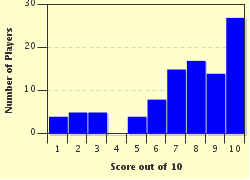Quiz Answer Key and Fun Facts
1. It was 24 days before Julia Gillard was sworn in as Australian Prime Minister following 2010's hung parliament election. Who missed out on becoming Prime Minister by the narrowest of margins?
2. In 2007, Kevin Rudd led Labor to its first victory at the national level in more than a decade. Who lost the mantle of Australian Prime Minister, as well as the job of Member for Bennelong?
3. John Howard won his fourth consecutive Australian election in October 2004. Who was the vitriolic Leader of the Opposition who left politics altogether three months later?
4. After lagging in the polls for most of the year, John Howard's Liberal/National Coalition went on to win the 2001 Australian federal election. Who was the Labor Party leader whose Prime Ministerial hopes were dashed?
5. Unusually, in the 1998 Australian election the leader of the party with the highest share of the vote after distribution of preferences did not become Prime Minister. Who failed to win the only tally that counts?
6. John Howard became Prime Minister of Australia in 1996, ending 13 years of Labor rule. Who was his logophilic predecessor?
7. After becoming Prime Minister of Australia through an internal leadership challenge, Paul Keating went on to win the so called "unwinnable" election in 1993. Who was his opponent, who snatched defeat out of the jaws of victory?
8. The March 1990 Australian election was Prime Minister Bob Hawke's fourth victory. Who was the Opposition Leader of whom the treasurer asked "Can the soufflé rise twice"?
9. In 1987 Bob Hawke called an early election in Australia, hoping to capitalise on disunity within the opposition Liberal Party. He succeeded, increasing his government's majority in the House of Representatives by 4 seats. Who was his vanquished foe?
10. Australian Prime Minister Bob Hawke went into the 1984 election with an approval rating of 75%, so his victory surprised nobody. Which unfortunate Opposition Leader didn't stand a chance?
Source: Author
lorance79
This quiz was reviewed by FunTrivia editor
stedman before going online.
Any errors found in FunTrivia content are routinely corrected through our feedback system.

